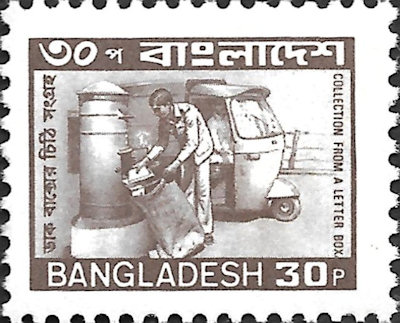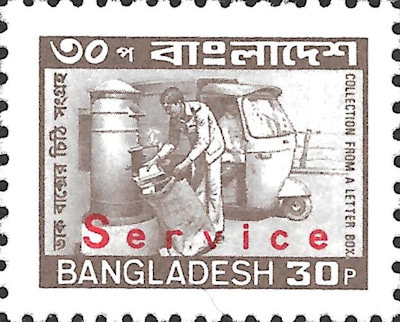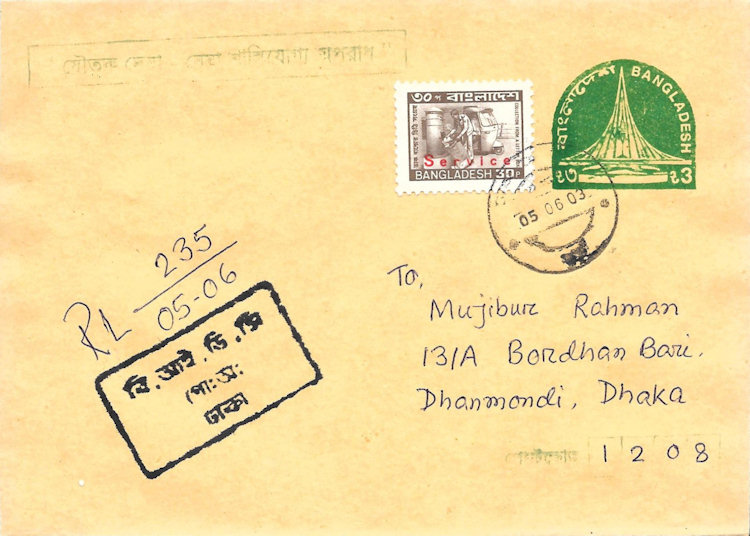Delicacy from the Land of Bengal
One of the most difficult stamps to find and score is the little lilac-brown "Service" stamp from Bangladesh, issued on December 21st 1983. On the stamp the image of a postman who is emptying a letter box, with in the background a Piaggo Ape, probably type Calessino, in Pakistan and Bangladesh called an Auto-Rickshaw.

The normal stamp with the 3-wheeler
The Rickshaw is manufactured under licence at, amongst others, Mahindra & Mahindra (were do we hear that name ofter nowadays??). This model was built as bare cabin 3-wheeler, and could be delivered at wish with various kinds of cargo space.
The stamp is the regular stamps, a so-called permanent issue, of 30 Poisha, the currency in Bangladesh since 1972
(100 Poisha = 1 Taka), provided with a low placed overprint in red with the word "Service".

The stamp with overprint "Service"
Right from the start Bangladesh in several years issued stamps with images of local motifs. These motifs had been re-used in different years. In 1983 a new series of definitives (permanent stamps) was ordered in Russia, the Mezhdunarodnava Kniga (the printer) issue, and this contained the Rickshaw stamp. This issue carried the English word Service, which was changed in later issues of the stamp into Bengal writing. In the following issues this specific stamp had suddenly vanished, while all other images were re-used. This makes that that only few of these Ape stamps exist, and only with English overprint.
But for which purpose have these stamps with Service overprint been made?
Most stamps in the world carrying the overprint "Service" are used to send post by authorities, the so-called Official Mail. Many countries however use this kind of service-stamps to pay for special services. In Bangladesh the service-imprint stamps were used to pay for special postal duties. For instance when you wanted to send a registered or express letter, the duties were payed for by sticking extra stamps on the letter. Thus payment for extra service.
But the rate for a normal letter
was in 1983 already 50 Poisha, and this made that the lower value additional stamps were soon not used anymore. Therefore these stamps were not longer made in large numbers. Our Ape stamp of 30 Poisha was one of the victims. This makes them much more scarce. Also the stamps with overprint were off course not used often and thus "cleared". The stamp was thus also not included in the next series of permanent stamps.
A trader in Bangladesh learned me that "our" Service stamp is at the moment one of the most sought-after by collectors in his country. And I must admit that also here, on this side of the world, we don't see it very often. The normal stamp is already often absent in series offered by traders, and the service type is…… scarce. On the other hand these stamps are not really expensive, but you have to pay around 10 euros. Stamps used on a letter are extremely difficult to find, and for them high prices are paid at auctions. The duties are still payed by sticking extra stamps, and often the Ape Service stamps that are still in circulation are used. Here a registered letter from 1997 (the Bangla year count lags behind with 597 years compared to ours):

Hans de Kloet
Top - Back to former page - Home |


